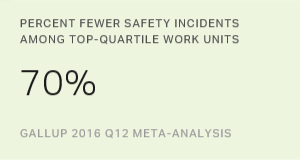Story Highlights
- Engaged cultures are safer places to work
- Strategic action can engage workers and promote safety
- Leaders need to foster a safe, engaged culture
When it comes to safety in the workplace, organizational culture can be quite literally a matter of life and death. Look no further than the example of BP.
As one of the world's largest oil producers, BP has a troubled safety record. As Forbes reports, one of BP's plants has an unusually tragic past, including an explosion in 2005 that killed 15 workers and injured 180. This plant also reported 23 worker fatalities in the three decades that preceded the 2005 accident.
When Marathon Petroleum, the fourth-largest oil refiner in the U.S., bought the plant from BP, many in the industry thought it was a risky move. But Marathon had ideas for how to rectify the situation by instituting a culture centered on safety.
Remedying the culture required a review of the plant's existing safety procedures. Following the 2005 explosion, federal investigators pointed to BP's problematic safety culture -- for example, with managers who were "checking off boxes" rather than promoting best practices for safety -- as the cause of the plant's many safety problems. BP failed to respond and paid dearly for its inaction in 2010, when the Deepwater Horizon drilling rig exploded, killing 11 and spilling more than 3 million barrels of oil. The incident cost the company $54 billion in damages.
As BP's record illustrates, organizational culture matters a great deal to employee safety. Cultures in which employees are engaged in their work are safer places to work. Gallup's 2016 meta-analysis study -- which examined more than 82,000 business units and 1.8 million employees in 230 organizations, across 49 industries and in 73 countries -- shows that business units with engagement scores in the top quartile of Gallup's employee engagement database have 70% fewer safety incidents compared with bottom-quartile units.

To create a culture focused on safety, leaders should implement targeted actions to improve engagement in the areas with the strongest links to safety. Organizations with top-notch safety cultures have the following in common:
Their employees are committed to doing quality work. When workers are committed to a standard of excellence in all they do, it's natural for them to adhere to best practices that prevent safety incidents. When employees are dedicated to quality, they go the extra mile to do things right the first time. By taking the right strategic action -- for example, by holding employees accountable for quality -- leaders can develop a workforce that makes smart decisions throughout the day and promotes a culture of workplace safety.
The mission or purpose of the company makes employees feel their job is important. Many of the world's most engaged organizations maintain a purpose-driven culture. Their leaders know why the company exists and ensure that employees understand and identify with that purpose. When workers embrace the mission of an organization and connect with that purpose both personally and professionally, they are more likely to think "big picture" in all areas of their work. Employees who are aligned with the company's mission are also more likely to approach their work with thoughtfulness and attention to detail, which contributes to a culture of safety.
Employees feel that their opinions count. It's a simple notion: Listen to workers who are closest to the action. These individuals offer a front-line perspective on organizational problems and often are well-versed in preventing and overcoming them. Leaders should encourage employees to watch for hazards and should make it easy for them to share their feedback and concerns. Most importantly, when leaders act on the information they receive, it demonstrates to employees that their opinions matter -- and it can help companies avoid preventable safety incidents.
An unsafe workplace can have far-reaching effects on a company and its employees. Productivity can suffer, and insurance claims can significantly damage a company's bottom line. But no company can quantify the cost of the most serious accidents. Any expenses to the business pale in comparison with the infinite cost to the families of the individuals whose lives were tragically lost on the Deepwater Horizon or who were killed or injured in the BP refinery explosion.
Given the potential consequences of a safety incident, leaders can't afford to be haphazard about safety. Regardless of industry or company size, all businesses need to do everything in their power to develop an engaged workforce that is committed to avoiding safety incidents. This means ensuring that employees are committed to quality work, believe in their company's mission and purpose and are confident in expressing their opinions. To keep employees safe, leaders need to create a culture of safety.
For former BP employees, the Marathon Petroleum acquisition -- and the cultural changes that have followed -- may create a safer environment that is the difference between life and death. As CEO Gary Heminger put it, "We've taken our culture into that refinery. We're going to operate it with the best safety and environmental skills available."
Stephanie Plowman contributed to the research in this article.
